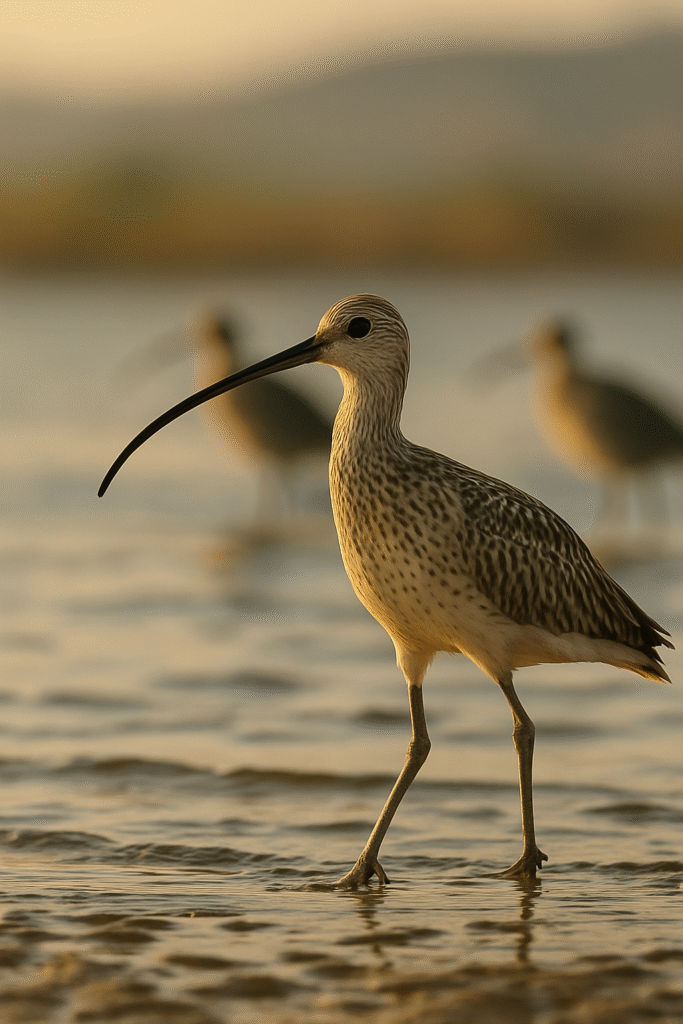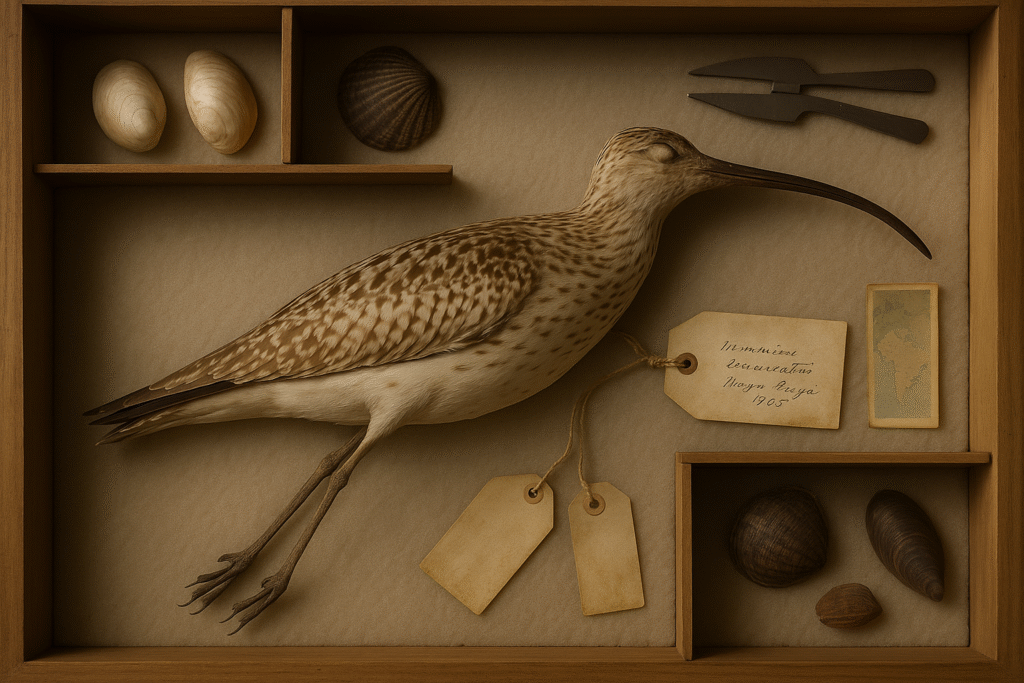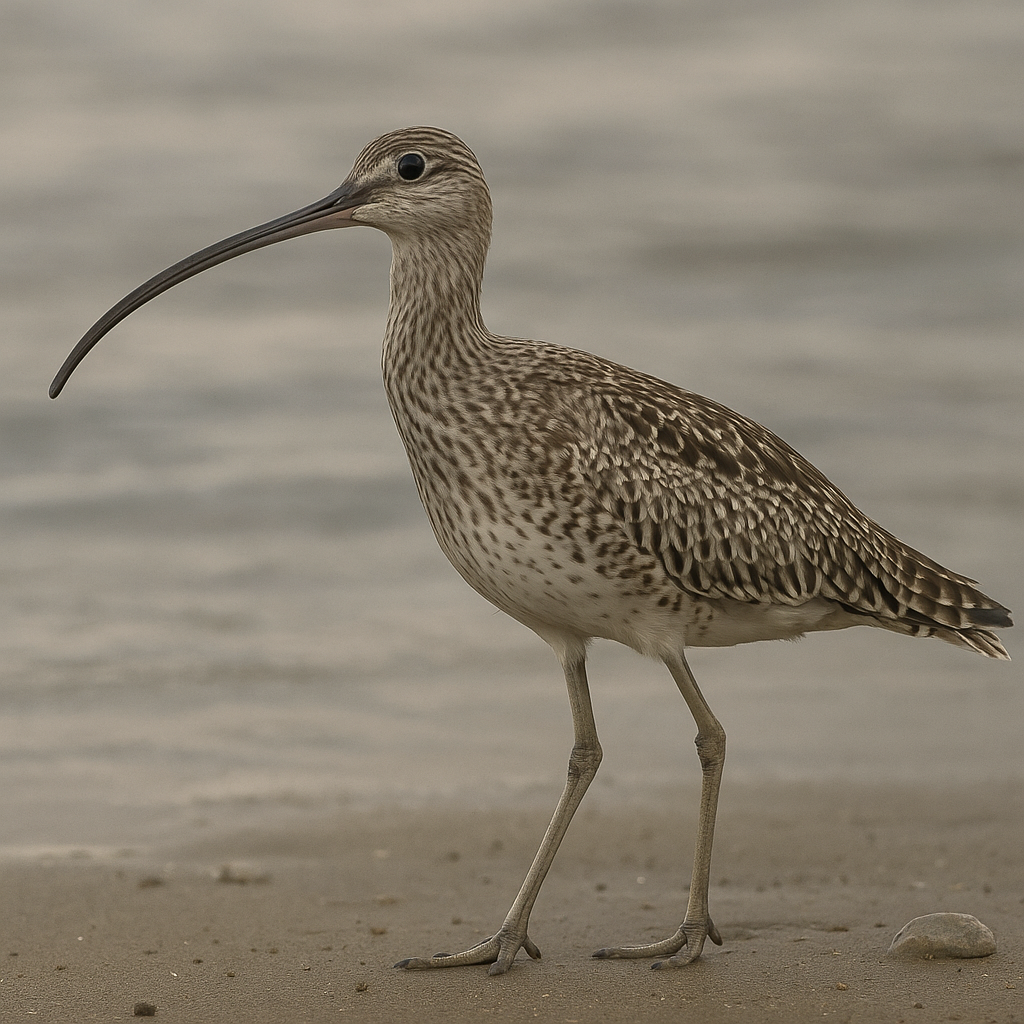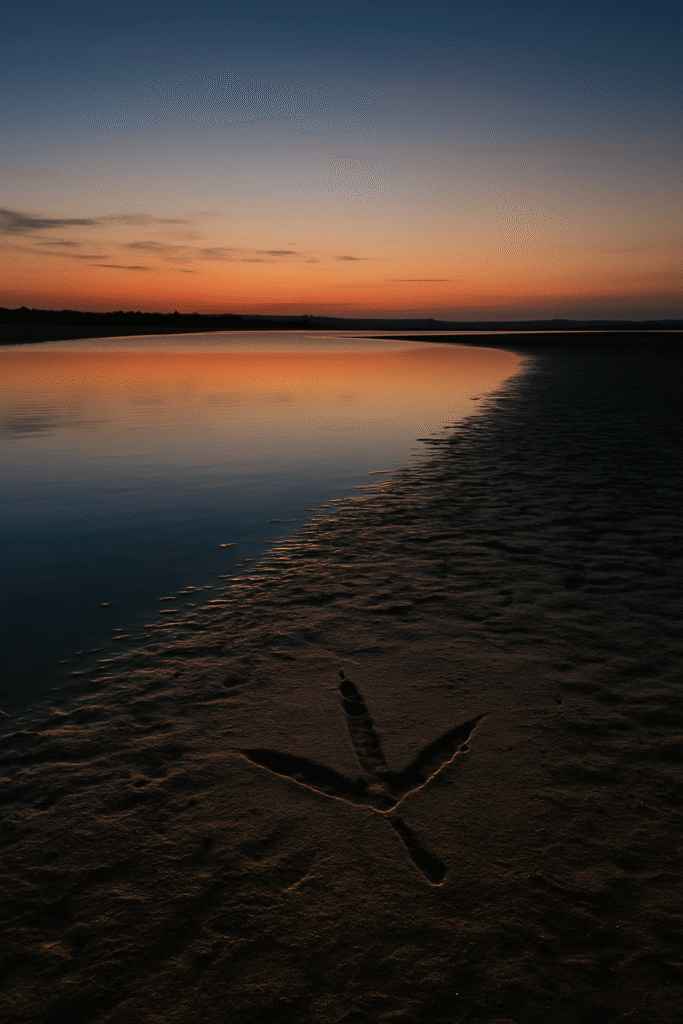The Slender-billed Curlew (Numenius tenuirostris) and the Cost of Hesitation
For nearly three decades, teams fanned out along the flyways of Africa, Europe, and the Mediterranean with scopes and notebooks, scanning every tideline and saltpan for a single curve of beak that would bend the silence back into birdsong. They watched. They listened. The air only answered with wind.
On 10 October 2025, that long silence was given its name. The International Union for Conservation of Nature has officially reclassified the Slender-billed Curlew as Extinct—the first globally extinct bird of mainland Europe, North Africa, or West Asia in modern times.

Its last confirmed record remains a bird photographed at Merja Zerga, Morocco, in February 1995. After that, every promising silhouette resolved into another species; every rumor dissolved on closer view.
This is more than the loss of a bird. It is the erasure of a story—of tundra and reedbed, of ancient stopovers and seasonal timing so precise that the year itself seemed to hinge on a flock’s arrival. It is a warning written in the place where tidewater turns to mirror: biodiversity can vanish faster than our institutions can react.
What We Lost
A bird built for distance.
The Slender-billed Curlew was a small, elegant member of the curlew clan, close kin to the Eurasian Curlew and Whimbrel yet distinct in form and pattern—finer, paler, shorter-billed, the breast and flanks peppered with neat, dark spots. Its long, down-curved bill reached deep for invertebrates: polychaete worms, small crabs, soft mollusks, beetle larvae. In flight it was quick and tight-winged, a wader scaled for long legs and long lines of coast.
A migration written across three continents.
It bred on wetlands and forest-steppe near the southern Siberian edge of the taiga—sites so remote and broad that even the last century’s best expeditions struggled to pin them down. Autumn sent it southwest across the Black Sea and Balkans to Mediterranean and North African wetlands: Italian lagoons, Greek salt lakes, Egyptian marshes, Tunisian chotts, and—at the Atlantic edge—Morocco’s coastal lagoons. Come spring, it threaded the route in reverse, timing its return to the great thaw.

A culture of places.
Curlews are not only birds of distance; they are birds of memory. A flock returns to the same broad place— the same lagoon margin, the same mudbar that bares at exactly the right tide—because older birds teach the route, and young birds survive by learning it. Break enough links in that chain and the map unravels.
How a Flyway Fails
Extinction on a migratory flyway is seldom a single blow; it is a cascade of small defeats.
- Wetlands narrowed and drained. Agricultural conversion, river “corrections,” and shoreline hardening deleted stopovers piece by piece. A bird that feeds by probing soft mud cannot eat on concrete.
- Hunting pressure. In parts of the Mediterranean and North Africa, legal and illegal shooting persisted well into the late 20th century. The rarer the bird became, the larger the incentive to take one “last specimen.”
- Confusion as a threat. The Slender-billed Curlew is subtle; distinguishing it from Eurasian Curlew at distance is a task for experts. That complexity throttled early protective action and complicated the last-chance searches.
- The arithmetic of small numbers. By the early 1990s, the population was already razor-thin. A harsh winter, a few bad breeding summers, a handful of guns at a key lagoon—that is all the math an extinction needs.
By 2024, a comprehensive scientific review concluded that the species was, with high probability, already gone; the 2025 IUCN Red List update has now made that verdict official.
The Science of an Absence
Declaring a species extinct is not done lightly. Conservationists and museums spent decades re-checking specimens, refining field identification, and re-searching rumored haunts. Teams deployed coordinated surveys across multiple countries, listened with parabolic microphones for calls that were never recorded, and even tested environmental DNA techniques in wetlands to scan for traces in water and sediment. The results converged: no evidence of persistence despite coverage that would have detected even a tiny, lingering population.

The last step is administrative but essential: a change in the Red List category from Critically Endangered (Possibly Extinct) to Extinct (EX)—a formal, sobering punctuation mark that turns years of doubt into a line we cannot cross back over.
What Its Disappearance Teaches Us
1) Flyways are only as strong as their weakest wetland.
A migrant that needs ten good stops cannot survive if three of them are compromised. Protection must be network-wide—from breeding marsh to winter lagoon, with the connective tissue (rest sites, floodplains, mudflats) intact.
2) “Common sense” is not data.
For years, many believed that curlews were too widespread to fail. By the time numbers were verified, the decline had become a slide. Monitoring must be frequent, standardized, and shared—so warning lights flash before a crash.
3) Identification matters.
When a species is hard to separate from its cousins, misreports waste effort and mask declines. Investments in training, photo documentation, and rapid expert review pay for themselves by steering fieldwork to where it counts.
4) Culture and law must align.
Where hunting is tradition, change is possible only if communities benefit from protection: jobs, pride, and access to managed wetlands as living places, not forbidden zones.
5) We cannot save a ghost by starving the living.
Once evidence shows a species is almost certainly gone, resources should pivot to safeguard the next most vulnerable—before they reach the same brink.
What We Can Still Protect—Starting Now
The loss of Numenius tenuirostris casts a long shadow over other shorebirds, including curlew cousins whose numbers are sliding.
- Guard remaining Mediterranean and North African wetlands as a connected system. That means controlling water extraction, banning new shoreline armor where mudflats can form, and restoring river–lagoon dynamics so sediment and nutrients move naturally.
- Design non-shooting corridors along migration bottlenecks, paired with community ranger programs and co-managed hunting reforms that phase pressure off key sites without vilifying local culture.
- Scale up wetland restoration in Europe’s inland basins. Re-wet peatlands, reconnect oxbows, and let floodplains breathe; shorebirds benefit alongside fisheries, carbon storage, and flood control.
- Invest in citizen science with teeth. Train observers to document diagnostic features, support cross-border data vetting, and equip teams with high-quality optics so rare birds aren’t lost in grainy images.
- Future-proof with climate realism. Sea-level rise will redraw coasts; we need roll-back space—undeveloped land behind current shorelines that can become tomorrow’s tidal wetlands.
How to Tell a Curlew from the Past from One That Remains
Field identification is not trivia; it’s triage. A quick primer for coastal observers:
- Bill: Slender-billed Curlew had a shorter, more evenly curved bill than Eurasian Curlew; females of Eurasian can show very long decurved bills that dwarf any slender-billed.
- Size & shape: Slender-billed was smaller and lighter-built with a relatively shorter neck; Whimbrel is shorter-billed but shows a distinct crown stripe (absent in Slender-billed).
- Flank patterning: Fine, roundish spotting on the flanks, not the long anchor-shaped streaks typical of Eurasian.
- Underwing: Slender-billed showed whiter underwings with finer markings than Eurasian’s darker, more densely marked underwing.
- Voice: Reports describe a higher-pitched, shorter call than the Eurasian’s bubbling fluting—another clue that went silent with the species.
This matters because other curlews—especially Eurasian Curlew and Far Eastern Curlew—still need accurate counts and protection. Learning the silhouettes we still have is part of honoring the one we lost.
A Short History of the End
- Early 1900s: Naturalists warn of declines in southern Europe; wetland drainage accelerates.
- Mid-century: Breeding grounds poorly known; wintering numbers diminish but persist at a handful of key sites.
- 1980s–1990s: Intensive surveys; Merja Zerga (Morocco) becomes the last reliable winter refuge. 1995 produces the final verified photographs.
- 2000s–2010s: Coordinated searches across Eurasia and North Africa fail to locate any individuals; IUCN maintains Critically Endangered (Possibly Extinct) status pending proof.
- 2024: A multi-institution review concludes the species is, with high probability, extinct.
- 2025: IUCN Red List changes status to Extinct; BirdLife International and treaty partners mark the loss as a global wake-up call for migratory bird conservation.
Grief With a Direction
Grief without action is only weather. Here is action:
- Adopt a wetland. Local groups can take responsibility for one lagoon, one river mouth, one saltpan—count birds, test water, advocate when plans would squeeze the marsh dry.
- Demand “net gain” for coasts. Infrastructure that takes tidal habitat must pay it back in new, functioning habitat—not token ponds.
- Buy food and tourism that fund wetlands. Support fisheries, farms, and guides tied explicitly to healthy marshes and seasonal water.
- Learn the birds. Teach them. Every new observer who can separate a Whimbrel from a curlew adds capacity; every child who hears a bubbling call carries a reason forward.
- Support the treaties that work. Migratory flyways only function with international cooperation; give your voice and vote to policies that keep water in wetlands and guns away from mudflats.
A Last Look
Imagine a winter morning at Merja Zerga decades ago. The light is pewter, the wind sketches calligraphy on the shallows, and lines of waders feed like sewing needles in the cloth of the tide. A smaller curlew, clean-spotted, lifts and arcs low over the reed fringe to another patch of soft mud. Nothing announces that this is the last winter anyone will be sure to see one.

A species is gone. The shoreline remains. Whether the next century’s air holds the fluting of curlews at all—whether migration continues to be a moving poem instead of a history lesson—depends on whether we treat this absence as a signal or a story we scroll past.
🕊️ A rare species is gone forever.
🌍 A warning to us all: protect what remains before memory becomes the only place they exist.


Reply